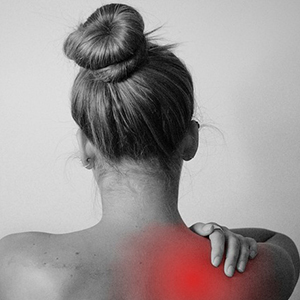Migraines and Women – Effects, Triggers, and Chiropractic
A study was published on October 25, 2023, in the Journal of Interdisciplinary Health Sciences with the title "The physical impact of migraines on female chiropractic patients: A qualitative study." The study was conducted in the eThekwini region of KwaZulu-Natal, South Africa.
 According
to the National Institute of Neurological disorders and
Stroke, "Migraine is a type of headache characterized by
recurrent attacks of moderate to severe throbbing and
pulsating pain on one side of the head." Migraines are one
of the most debilitating types of headaches. The American
Migraine Foundation estimates that at least 39 million
Americans suffer from migraines which affect women three
times more often than men.
According
to the National Institute of Neurological disorders and
Stroke, "Migraine is a type of headache characterized by
recurrent attacks of moderate to severe throbbing and
pulsating pain on one side of the head." Migraines are one
of the most debilitating types of headaches. The American
Migraine Foundation estimates that at least 39 million
Americans suffer from migraines which affect women three
times more often than men.
The researchers in this study investigated three "themes" as they called them, concerning women who were experiencing migraine headaches. The first theme reviewed how often the woman had migraines and what seemed to be the "trigger" factors that started their migraines. The second theme dealt with the physical effects of the migraines and how they impacted the woman's daily life. The third theme examined how chiropractic care affected the women's migraines and their views on chiropractic care for migraines.
The first theme in this study showed that most of the women suffered from severe and excruciating pain usually on one side of their head near their temples or behind their eyes. The woman would typically characterize the pain as heavy, throbbing and pounding. One of the women in the study described their migraine by saying "I get a throbbing sensation behind my eyes and behind my forehead. The pain runs from the front of my head all the way through to the back. Majority of the time it's on one side." All the woman shared that the migraines left them incapacitated and unable to function in their daily life.
In looking at the second theme involving triggers, the researchers found that many of the women related their migraine attacks to their hormonal cycles. All the women stated that stress was a major factor in triggering a migraine. Some also noted that weather, bright light, certain foods, or dehydration could trigger a migraine.
All the woman in this study underwent chiropractic care for their migraines. Their reactions to chiropractic were overall very positive. They reported that chiropractic reduced the frequency and severity of their migraines, as well as their disability and the duration of suffering. One of the women in the study reported, "When it comes to pain, it has reduced significantly after going to a chiropractor… the quality of life is so much better now. It's one of the only things that helped me." Another woman commented how chiropractic helped her when drugs could not, "I can take as much medicine as I want to and it just doesn't help, and as soon as I go to the chiropractor it definitely helps."
In their conclusion, the authors summed up their findings by stating, "The majority of the participants experienced moderate to severe chronic migraines and migraines without aura. During their migraine attacks, the participants experienced debilitating effects, felt mentally or physically incapacitated, described that their life came to a standstill, were unable to complete daily activities and had a resultant decreased quality of life. The study highlighted that chiropractic treatment was favourable (sp) among the female population in improving the quality of life and reducing the severity, disability, duration of suffering and frequency of migraines."
 In
this case, a 4-year-old boy was brought to the chiropractor
by his mother. The boy had been previously diagnosed with
ASD. The mother reported that her son was exhibiting
aggressiveness, suffered from speech delay, had poor eye
contact and was hyperactive. She also reported that her son
would hit anyone who gets close to him and would also bang
his head on the floor whenever he got frustrated or angry.
In
this case, a 4-year-old boy was brought to the chiropractor
by his mother. The boy had been previously diagnosed with
ASD. The mother reported that her son was exhibiting
aggressiveness, suffered from speech delay, had poor eye
contact and was hyperactive. She also reported that her son
would hit anyone who gets close to him and would also bang
his head on the floor whenever he got frustrated or angry. In
this case, a 28-year-old woman went to see a chiropractor
for joint pain and swelling. The woman reported that she was
suffering with the joint pain and swelling for the past
three years. She recalled that her problems seemed to start
three days after falling off a fence. The pain was frequent
and was worse in the mornings. Oddly, her pain only affected
one joint at a time, but the pain would migrate between her
shoulders, knees, feet, and hands. When her problems flared
up, her joints appeared red and swollen, and would be hot to
the touch. Not long after her problems began, the woman was
diagnosed as having RA and placed on medications.
In
this case, a 28-year-old woman went to see a chiropractor
for joint pain and swelling. The woman reported that she was
suffering with the joint pain and swelling for the past
three years. She recalled that her problems seemed to start
three days after falling off a fence. The pain was frequent
and was worse in the mornings. Oddly, her pain only affected
one joint at a time, but the pain would migrate between her
shoulders, knees, feet, and hands. When her problems flared
up, her joints appeared red and swollen, and would be hot to
the touch. Not long after her problems began, the woman was
diagnosed as having RA and placed on medications. In
this case, a 58-year-old woman went to the chiropractor for
help with symptoms from her Parkinson's disease. She had
been diagnosed with PD one year before seeking chiropractic
care. Her symptoms included pain in her shoulder and tremors
in her right arm. Her general movements were slow and jerky
which is typical in patients with PD. The woman's intention
for seeking chiropractic care was to get relief from the
symptoms she was experiencing with the PD.
In
this case, a 58-year-old woman went to the chiropractor for
help with symptoms from her Parkinson's disease. She had
been diagnosed with PD one year before seeking chiropractic
care. Her symptoms included pain in her shoulder and tremors
in her right arm. Her general movements were slow and jerky
which is typical in patients with PD. The woman's intention
for seeking chiropractic care was to get relief from the
symptoms she was experiencing with the PD.